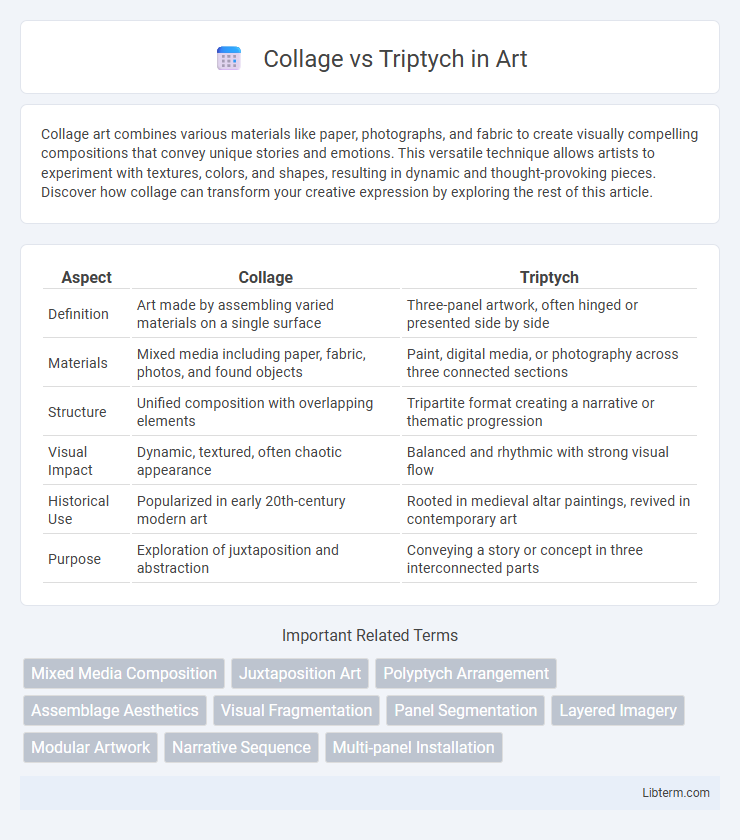Collage art combines various materials like paper, photographs, and fabric to create visually compelling compositions that convey unique stories and emotions. This versatile technique allows artists to experiment with textures, colors, and shapes, resulting in dynamic and thought-provoking pieces. Discover how collage can transform your creative expression by exploring the rest of this article.
Table of Comparison
| Aspect | Collage | Triptych |
|---|---|---|
| Definition | Art made by assembling varied materials on a single surface | Three-panel artwork, often hinged or presented side by side |
| Materials | Mixed media including paper, fabric, photos, and found objects | Paint, digital media, or photography across three connected sections |
| Structure | Unified composition with overlapping elements | Tripartite format creating a narrative or thematic progression |
| Visual Impact | Dynamic, textured, often chaotic appearance | Balanced and rhythmic with strong visual flow |
| Historical Use | Popularized in early 20th-century modern art | Rooted in medieval altar paintings, revived in contemporary art |
| Purpose | Exploration of juxtaposition and abstraction | Conveying a story or concept in three interconnected parts |
Understanding Collage and Triptych: Key Definitions
A collage is an artistic composition created by assembling various materials such as paper, photographs, and fabric onto a surface, emphasizing texture and layering to convey a unified theme. A triptych, rooted in classical art, consists of three connected panels that together tell a continuous story or explore a singular concept through segmented visuals. Understanding these key definitions highlights the collage's focus on mixed media integration versus the triptych's narrative structure through spatial division.
Historical Origins and Artistic Evolution
Collages originated in early 20th-century avant-garde movements, notably Cubism and Dadaism, as artists like Picasso and Braque combined disparate materials into unified compositions, challenging traditional artistic boundaries. Triptychs have roots in medieval Christian art, evolving from religious altarpieces into contemporary formats that explore narrative and thematic complexity through three connected panels. Both forms demonstrate significant artistic evolution, with collages emphasizing juxtaposition and textural interplay and triptychs focusing on sequential storytelling and spatial relationships.
Visual Structure: Comparing Layouts
Collages feature a dynamic visual structure by combining multiple images or materials in overlapping layers, creating a rich, textured depth that invites exploration. Triptychs use a tripartite layout, dividing content into three distinct panels arranged side-by-side or vertically, emphasizing symmetry and narrative progression. The collage's irregular composition contrasts with the triptych's balanced format, each offering unique visual storytelling techniques.
Narrative and Storytelling in Both Formats
Collages blend diverse images and textures to create layered narratives that evoke complex emotions and multi-dimensional stories, often allowing viewers to interpret connections uniquely. Triptychs use three distinct yet related panels to present sequential or thematic storytelling, guiding the audience through a clear progression or contrast in the narrative. Both formats enhance visual storytelling by structuring imagery to engage viewers in deep, interpretive meaning-making.
Popular Techniques and Materials Used
Collage art commonly employs paper, fabric, photographs, and mixed media layered on canvas or board, utilizing adhesives like glue or gel medium to create diverse textures and visual depth. Triptychs often feature oil or acrylic paint on three connected panels, emphasizing continuity and thematic storytelling through precise brushwork and color harmonization. Both techniques embrace various materials but differ in presentation: collage prioritizes tactile assembly, while triptychs focus on segmented yet unified compositions.
Emotional Impact and Audience Engagement
Collage combines diverse images and textures, creating a layered emotional impact that encourages viewers to explore connections and interpret meanings deeply. Triptychs use three related panels to present a cohesive narrative or contrasting themes, guiding the audience through a structured emotional journey. This format often fosters strong engagement by highlighting progression or tension across the panels, making the experience more immersive and thought-provoking.
Collage in Contemporary Art Practices
Collage in contemporary art practices utilizes diverse materials such as photographs, textiles, and paper fragments to create layered, multidimensional artworks that challenge traditional narratives and visual perceptions. Unlike triptychs, which are structured as three-paneled compositions often rooted in historical or religious contexts, collages emphasize fragmentation and juxtaposition to explore identity, memory, and social commentary. Contemporary artists leverage collage techniques to deconstruct visual language, enabling innovative expressions within mixed media, conceptual art, and postmodern aesthetics.
Triptych: Traditional vs. Modern Interpretations
Triptych art originated as a traditional three-panel work often used in religious contexts, characterized by intricate narrative and symbolic imagery. Modern interpretations of the triptych expand beyond religious themes, incorporating abstract, digital, and mixed media elements to create dynamic visual experiences across the three interconnected panels. This evolution highlights the triptych's versatility, contrasting with collage, which involves combining diverse materials into a single composition rather than segmented panels.
Choosing Between Collage and Triptych for Your Artwork
Choosing between a collage and a triptych depends on the artistic narrative and visual impact you want to create. Collages offer a dynamic mixture of textures and images, allowing for layered storytelling and abstract expression, while triptychs present a structured, three-panel format that emphasizes sequence and thematic progression. Consider the spatial context and viewer engagement to determine if a fragmented collage or a cohesive triptych best conveys your artistic vision.
Expert Tips for Creating Impactful Artworks
Collages combine diverse materials like paper, fabric, and photographs to create layered, textured compositions, while triptychs consist of three interconnected panels that explore a theme through sequential or contrasting imagery. Experts recommend balancing color harmony and thematic coherence to ensure each piece, whether in a collage or triptych, contributes to a unified visual impact. Strategic use of scale, negative space, and focal points enhances narrative depth and emotional engagement in both art forms.
Collage Infographic

 libterm.com
libterm.com